23 BEST Things To Do In The Italian Dolomites

Also known as the Pale Mountains, the Dolomites are named for the carbonate rock from which they are formed. The range is in northeastern Italy and is part of the Southern Limestone Alps. Diverse natural beauty abounds here, and the main draw is an outdoor adventure within the stunning scenery. Any visitor to the area will be overwhelmed by the sheer amount of things to do in the Italian Dolomites.
An alpine paradise, the enchanting landscape is covered with snow-capped peaks, shimmering lakes, and pine forest that feels like stepping into an otherworldly serene setting. Enjoy all the best this area offers with these things to do in the Dolomites.
Introducing the Dolomites
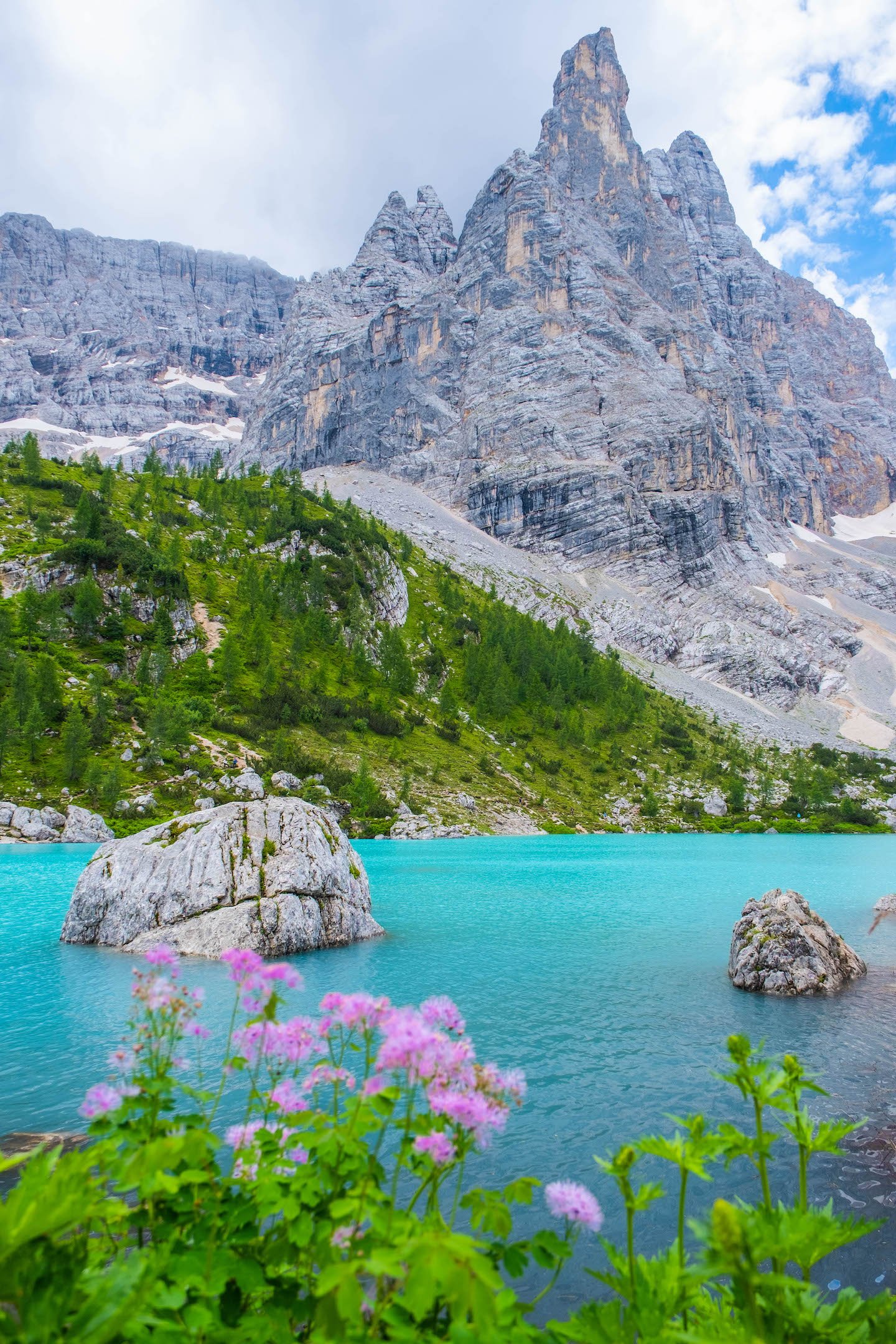
The Dolomites are a mountain range in northeastern Italy. It spans many regions, including Veneto, Trentino, Sudtirol, and Friuli-Venezia Giulia. The Dolomites are renowned for their dramatic scenes and wild geology, with massive towers of rock. In 2009, UNESCO declared them a World Heritage Site due to their exceptional beauty and unique natural landscape.
Throughout the years, the Dolomites have been disputed, and men have died to conquer the mountains. The Italian and Austrian army front lines ran through the region during the First World War. It’s said that some of the worst fighting in the war happened along the same trails and routes that hikers now enjoy.
On some hikes, you’ll find open-air war museums and the mountains have hundreds of “Via Ferrata” paths created during the war. Despite their previous dark history, the mountains have a distinct culture that blends Austrian and Italian heritage.
Things to Do in the Dolomites
Lago Di Braies

Set in the Prags Dolomites in South Tyrol, Lago Di Braies is a pristine and picturesque alpine environment for a peaceful adventure in nature. Aside from the other tourists flocking to see the scenery, of course, it’s one of the most beautiful and famous lakes to visit in Europe. Like most popular spots, we found it busy for good reason, but it was still worth the visit.
The crystal clear waters perfectly reflect the enchanting landscape, including the surrounding snow-capped peaks and towering evergreens. Ancient folklore says that it’s a magical gateway to an underground kingdom or sunken treasures waiting to be discovered, and its unearthly charm makes this easy to believe. You can pop in and snap a perfect pic or take the time to wander the two-mile trail all around the stunning surroundings.
Alpe Di Siusi

Alpe Di Siusi is a beloved plateau in the Italian Dolomites and the highest alpine meadow in all of Europe. It’s located in South Tyrol, and it’s most known for ample skiing and hiking opportunities. There are 30 miles of slopes to soar down and 18 miles of cross-country trails to trek.
It’s a sunny paradise for outdoor sports in any season. It even boasts the biggest snow park in the region. The beautiful backdrop of Mount Sciallia here only adds to the spectacular space made for skiers, snowboards, hikers, and snowshoers from all over the world.
Tre Cime National Park
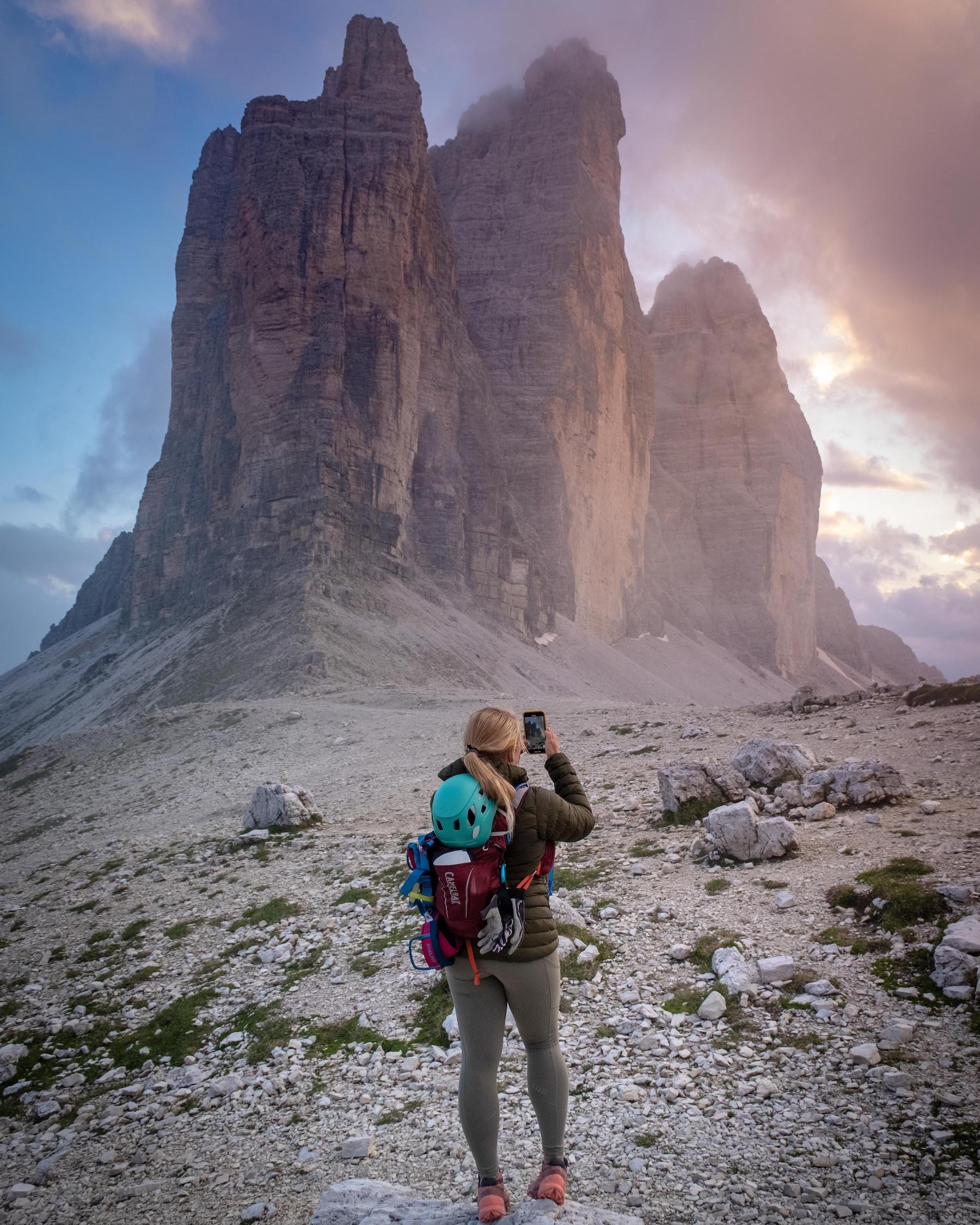
Translated to Three Peaks Park, this is a treasure trove full of natural wonders in the Dolomites. It’s truly one of the most beautiful places in Europe. If you can only do one thing in the Dolomites, it should be to head to Tre Cime. The park has plenty of hiking trails, but one of the most popular is a 6.2-mile heavily trafficked loop that requires a moderate hiking skill level.
It’s characterized by a collection of large and unusual mountain rock formations. These include Cadini di Misurina, which resembles a set of needles; Monte Paterno, which appears as a pyramid; and Croda Rosa, which many see as an open rosebud.

The namesake, which has become the famous symbol of the Dolomites, is Tre Cime di Lavaredo, which looks like sharp teeth. There are many high peaks, canyons, and large boulders that often fall from the peaks at any given time.
There’s plenty of rare native flora and fauna to spot on your enchanting hike or climbing adventure. Pack a lunch or hike to the famous Rifugios, where you can have a glass of wine and schnitzel while enjoying the mountain views. Our favorite rRifugio in the Dolomites is, without a doubt, Rifugio Auronzo.
Via Ferrata Innerkofler/De Luca

If you are already heading into Tre Cime one of the best things to do in the Dolomites is rent some via ferrata equipment or consider adding it to your Europe packing list and enjoy the epic via ferrata Innerkofler. It’s a fantastic beginner via ferrata that is thrilling and provides the most stunning views of the three peaks at the summit.
This ferrata starts near Rifugio Locatelli and takes you to the summit of Monte Paterno. This via ferrata is child-friendly, with only a few difficult sections. The beginning of the via ferrata takes you through some very interesting and almost eerie old war bunkers, so bring a headlamp as it’s very dark! It will take a couple of hours to complete and was one of our favorites via ferratas in the Dolomites!
Lago di Carezza
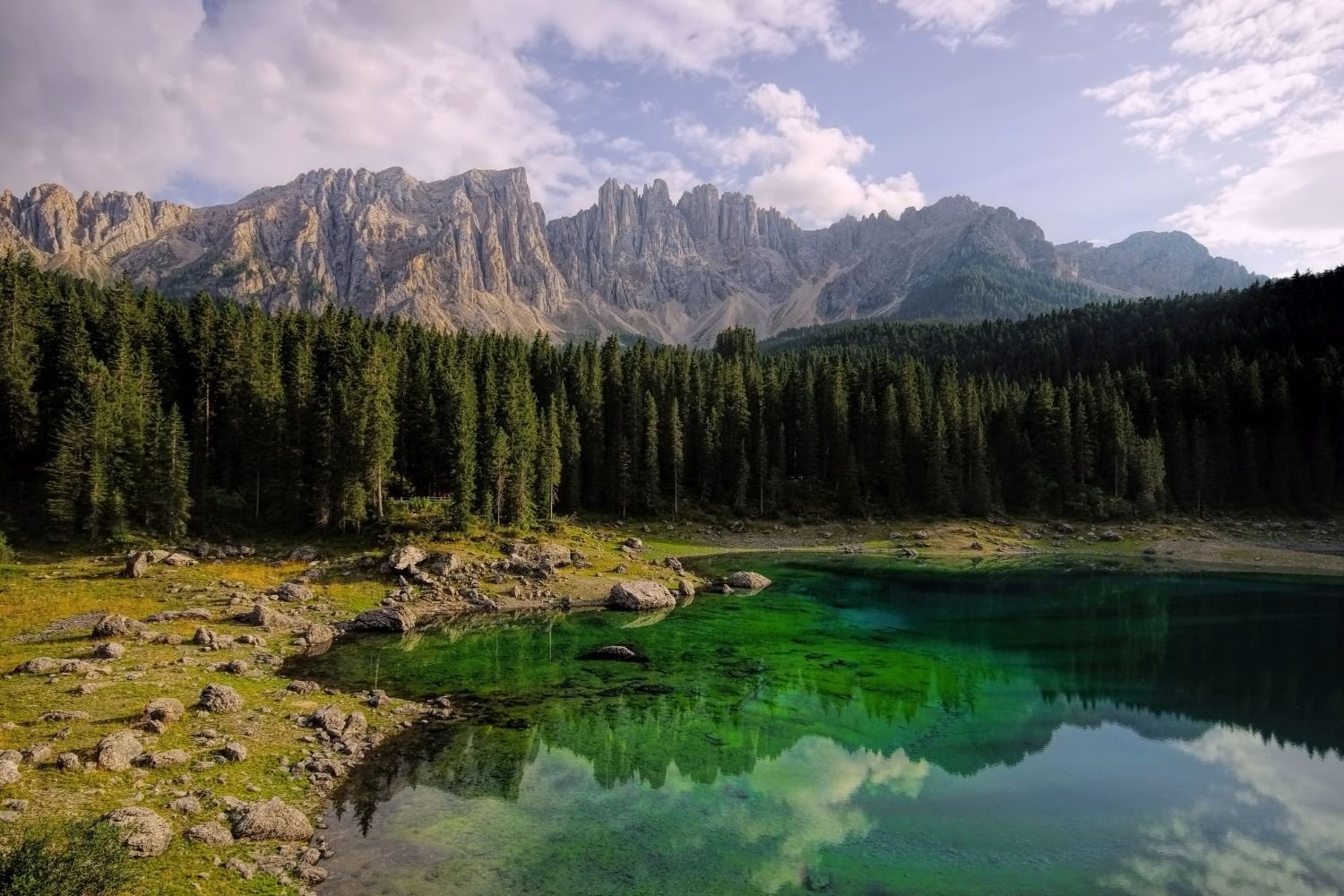
Lago di Carezza is a small alpine lake nestled in the Dolomites. It’s a delight to visit, known for its striking and vibrant color and sweeping vistas of the majestic Latemar Mountains. It’s commonly called Rainbow Lake, named after a local legend you’ll learn all about.
It has been deemed one of the most beautiful bodies of water in the world, and it’s set almost 5,000 feet above sea level. Aside from photography, hiking and mountain biking are popular pastimes in the area. A loop around the lake is short and flat, so it’s easy to navigate and enjoy the beauty from every angle.
Seceda Ridgeline

Hiking the Seceda Ridgeline is a quintessential experience in the region. Depending on your chosen trail, it takes a few hours to complete. The trail is located in the Val Gardena region and is easily accessible by gondola and cable car.
The highest point in the area is at an altitude of 8,000 feet, which has been deemed a medium level of difficulty, with a few steep sections of the trail. The viewpoints along the well-maintained path are worth it, and it’s a great way to spend a day admiring the breathtaking scenery. The Baita Troier Hutte is the best place to stop to enjoy a bite, a beverage with a spectacular backdrop, and some adorable alpaca friends.
Passo Giau

The Passo Giau is located in the Belluno Province in Italy. It serves to connect Cortina d’Ampezzo with Colle Santa Lucia and Selva di Cadore. This high mountain pass is about as picturesque as it gets, set in the middle of an expansive pasture at the foot of several formidable peaks.
It’s easy to see why it’s the most popular of all the Dolomite passes. From its unique vantage point of 7,703 feet high, it looks out over the gorgeous landscape. Get here early to get the view without all the cars and other tourists. Several hikes start from here, and the surroundings are stunning in any season.
Via Ferrata Averau
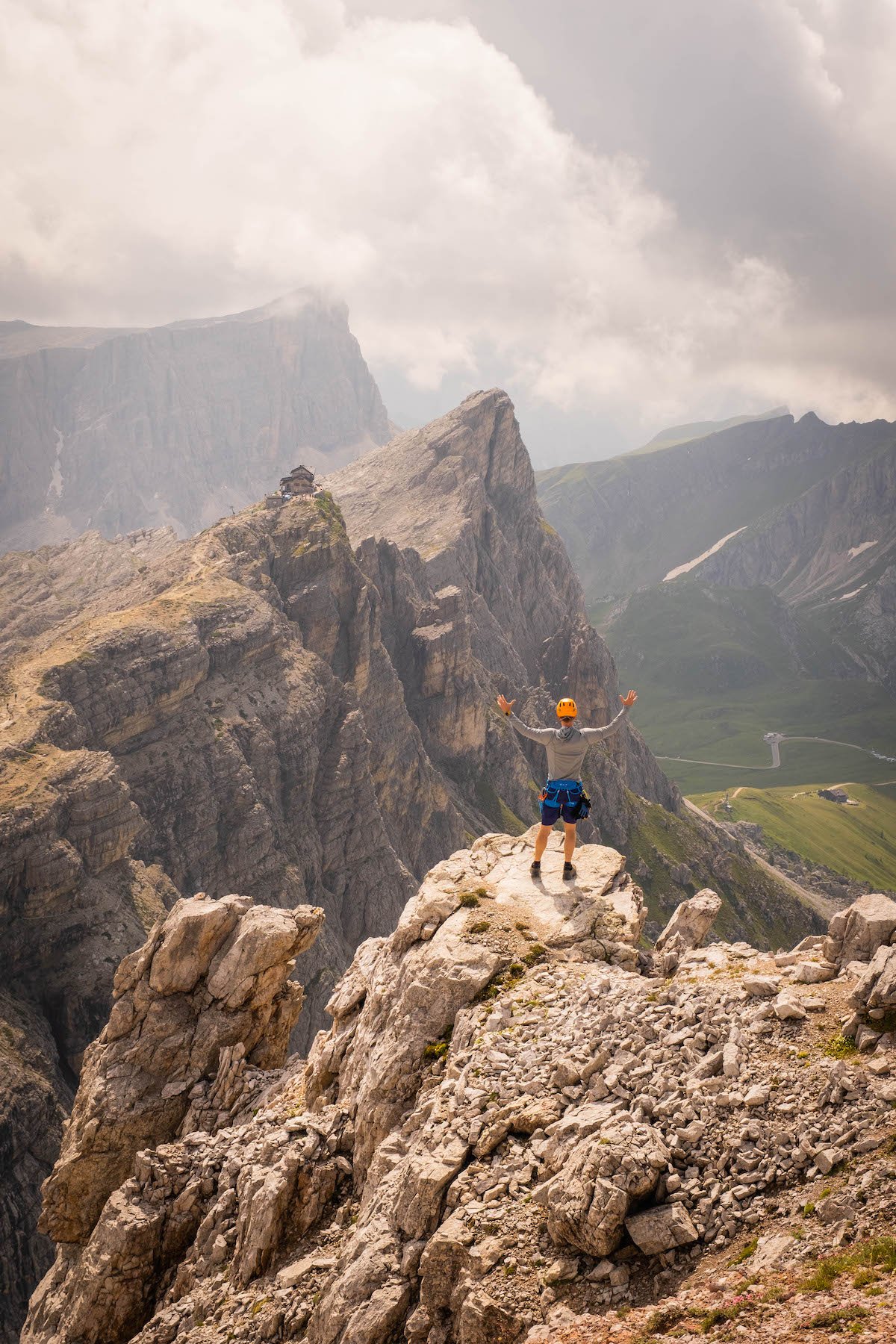
Near Passo Giau is a thrilling via ferrata with fantastic views from the summit. Via ferrata, Averau is beginner-friendly and only 230 meters from the summit. There are multiple ways to access this via ferrata. The easiest is to take the chairlift to the Averau hut, where you will begin via ferrata.
This fun adventure takes between 2-3 hours and only has a few slightly exposed points. At the summit, you’ll get the most amazing views of Rifugio Nuvolau, Ra Gusela, and Mount Pelmo. This one is busy! So get here early in the morning to beat the crowds.
Val Di Funes

Whether you are backpacking or on your honeymoon, everyone should prioritize seeing Val Di Funes. This little captivating corner of Italy is an idyllic escape everyone will enjoy. It’s become famous for a few of its charming churches but has so much more to offer.
Rolling green meadows and dramatic rocky spires, like the iconic Odle peaks, create an idyllic setting to explore. It feels like something straight out of a storybook, with miles of unspoiled forest stretching as far as the eye can see. There are several great hikes and walks through the forest, with several accessible in the winter.
Ski at Cortina D’Ampezzo

A ski resort in northern Italy, the Cortina D’Ampezzo was the site for many Winter Olympic events in 1956. It’s part of the Dolomiti Superski area, including the Falzarego Pass. It’s visited for its beauty, heritage, and endless opportunities for colder outdoor sports. It’s one of our favorite places to visit in Europe in winter.
It’s hard to beat this gem if you’re looking to soar down some snowy slopes, as there’s a reason it’s called the Queen of the Dolomites. There’s an ice stadium, bobsleigh run, and snow park alongside an absurd amount of state-of-the-art runs. In the summer, Cortina is an awesome town to walk around, eat in, and browse the high-end shops. It is also one of the best places to base yourself for exploring the Dolomites.
Lago Sorapis
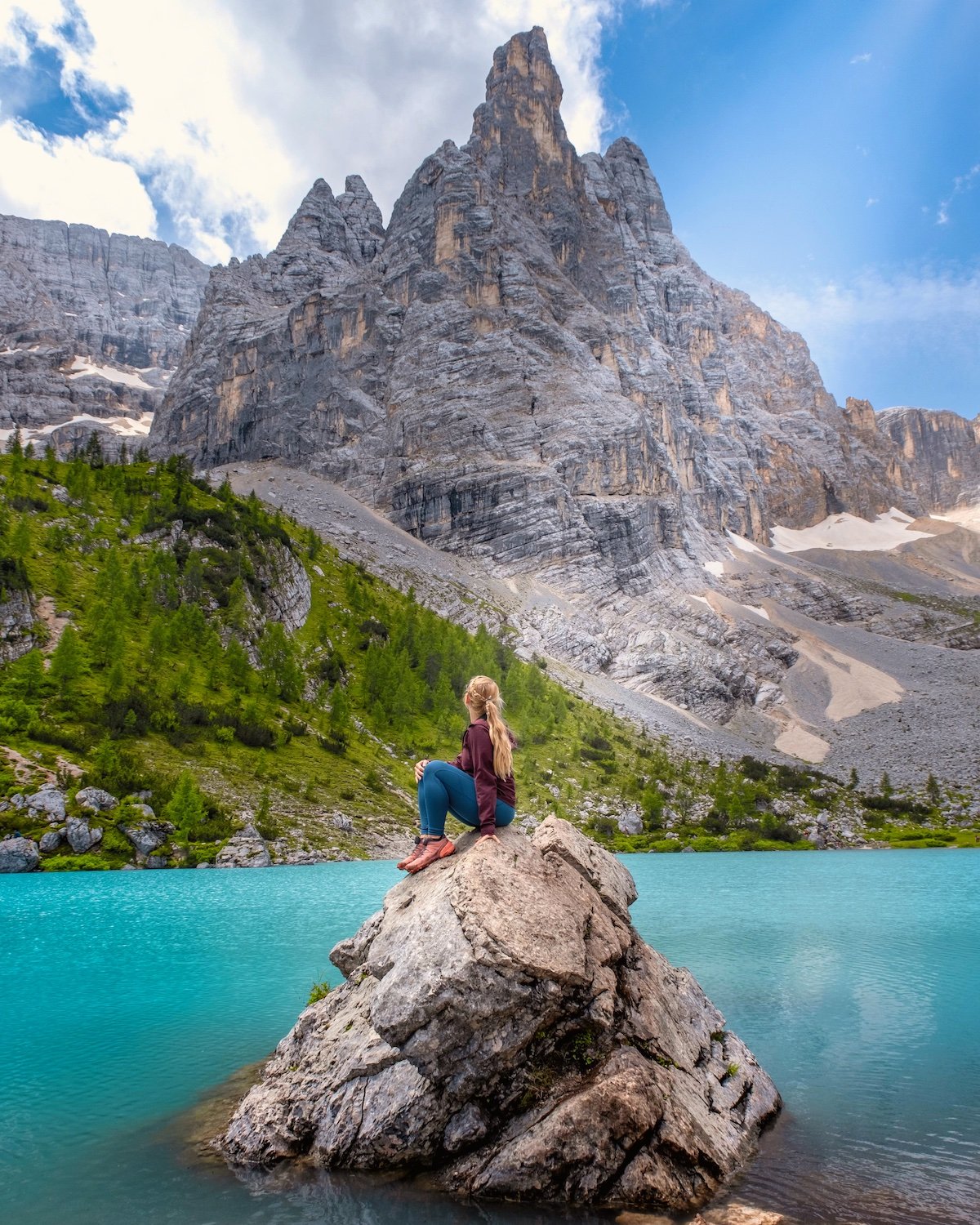
Deep within the Sorapiss mountain range of the Dolomites lies a breathtaking lake. Lago Sorapiss is 6,316 feet above sea level and can only be accessed by foot or helicopter. It’s known for its distinctive bright colors, from light blue to turquoise. The lake’s hue comes from rock flour from the meltwater off the Sorapis glacier.
The trail to arrive is spectacular, with varied terrain and plenty of vistas. Some sections are easy to navigate, and other steep sections are decked out with metal ladders and cables. It’s one of the most popular hikes in the Dolomites, and if you hit the trail on a beautiful summer day like we did, you’ll likely be hiking with a thousand other people. Consider getting an early sunrise start to beat the crowds.
Lago Federa

Lago Federa is a quaint mountain lake that’s integral to one of the most famous hikes in the Dolomites called Crodo de Lago. As such, doing the full eight-mile loop for the entire experience is recommended. It’s exceptionally breathtaking in the autumn season for its fantastical foliage. The difficulty is moderate at an elevation of 2,500 feet. You’ll cross cute bridges, meander through dense forests, and take in some dramatic panoramas.
Cinque Torre

This is a stunning rock formation with five towers, each with its own name. The tallest reaches an altitude of 7,746 feet. It has a rich history as well, as the site of many shelters for the Italian army built during WWI. Today, many have been restored and made into open-air museums. Great hiking and trail opportunities are all around Cinque Torre, so you’ll want to spend at least half a day exploring!
It’s a hotspot for climbing in the area, with a wide array of routes of varying grades up and down the individual towers. In recent years, it’s also become popular for skiing in the winter season. A traditional rifugio lodge can be found at the feet of these rugged peaks for a peaceful and picturesque vantage point.
Vajolet Towers Trail

The Vajolet Towers consist of six separate peaks towering above the alpine landscape like jagged teeth and are set in South Tyrol. So much so that centuries-old folklore maintains it’s the open mouth of a sleeping giant. It’s a happening spot of daredevils who come to climb and high-line.
Even the trail can be a bit challenging, so it’s not for faint-of-heart hikers. It’s often less crowded than some of the other Dolomite destinations. There are three routes to choose from, all of which will take the better part of a day.
Enjoy South Tyrol Cuisine

If you work up an appetite in South Tyrol, as you’re likely to do, be sure to stop in at any of the quintessential eateries around town. This region is known for its many delicious delicacies, from speck dumplings to apple strudel.
Local and fresh ingredients are used to create culinary masterpieces inspired by flavors from Italy and Austria and recipes passed down over hundreds of years. Get ready to treat your taste buds and try some of everything, such as Knodel, Schlutzkrapfen, Marende, Baurengrostel, and even Tiroler Pizza.
Via Ferrata Torre Di Toblin

This is a demanding via ferrata route with plenty of payoff in the north face of Torre Di Toblin. Also known as the delle Scalette, it’s half ladders and half steel ropes, with a total elevation gain of 1,800 feet. It’s short, super steep, and extremely exposed.
It’s best for those with a few via ferratas under their belt, as some sections will have you trembling. It was my first “moderate” via ferrata in the Dolomites, and I couldn’t believe how amazing it was! Arm strength and an ability to deal with heights are essential, and it’s a great way to practice for more difficult via ferratas. It was also once used as an outpost for Austrian soldiers during WWI.
Lagazuoi Tunnels

The Lagazuoi Tunnels are a 3.8-mile out-and-back, moderately trafficked trail. It’s located very close to Cortina d’Ampezzo, which is famous for its wondrous fields of wildflowers. The trail is accessible year-round and is not your average via ferrata.
It runs inside a mountain and is entirely equipped with cables. It’s a well-preserved and even educational route, where you can learn about the interesting history of the tunnel network. The total elevation gain is 2,200 feet.
Lago Limedes

For a quick and easy outing, visit Lago Limedes near the Falzarego Pass, a perfectly picturesque setting in the Dolomite Mountains. If you’re looking for an outdoor excursion that doesn’t require as much time or skill, it offers all the iconic scenery of the area.
If you’re hoping for more of a challenge, combining this trail with another hike in the area is also quite simple. It’s just a little over a mile round trip and offers some truly jaw-dropping vistas of Rifugio col Gallina, with iconic range peaks reflected in the calm and clear waters.
Lago Antorno

Lago Antorno is a small mountain lake, but it offers an ideal setting for picture-perfect shots. The sunset view is particularly captivating. A trail traverses the entire body of water and overlooks the Tre Cime di Lavaredo. It provides a relaxing respite in the idyllic scenery at any time of the year, and you won’t soon forget it.
Gardena Pass

Set in South Tyrol, the Gardena Pass is an iconic fixture of the outdoor enthusiast scene in the Dolomites. At just over 7,000 feet above sea level, it connects Val Gardena to Val Badia. You can drive through or go by foot, but either way, the diverse terrain is sure to surprise and delight. There are also plenty of accommodations right along the pass for visitors to stop and stay awhile and soak up the spectacular environment.
Lago di Dobbiaco / Toblacher See

Toblah is located in Alta Pusteria of South Tyrol, and Toblacher See is a tiny lake with a big and beautiful impact. It’s a great choice if you’re hoping to avoid the crowds, as it’s a bit off the beaten tourist path. It’s right off the main road, which makes it super accessible. It boasts turquoise waters surrounded by verdant forests and dramatic peaks.
Lago di Landro

A hidden gem of the Dolomites, Lago di Landro is the perfect alpine paradise. It’s one of the best spots to pack a picnic and bask in the beauty with a bite to eat. Though it’s on the smaller side, the mountains reflecting in the crystalline waters are mesmerizing. There’s a cute cafe and a few restaurants, plus adorable activities like boat rides are available. Plenty of trails on either side of the valley for various skill levels can also be explored here.
Madonna Di Campiglio
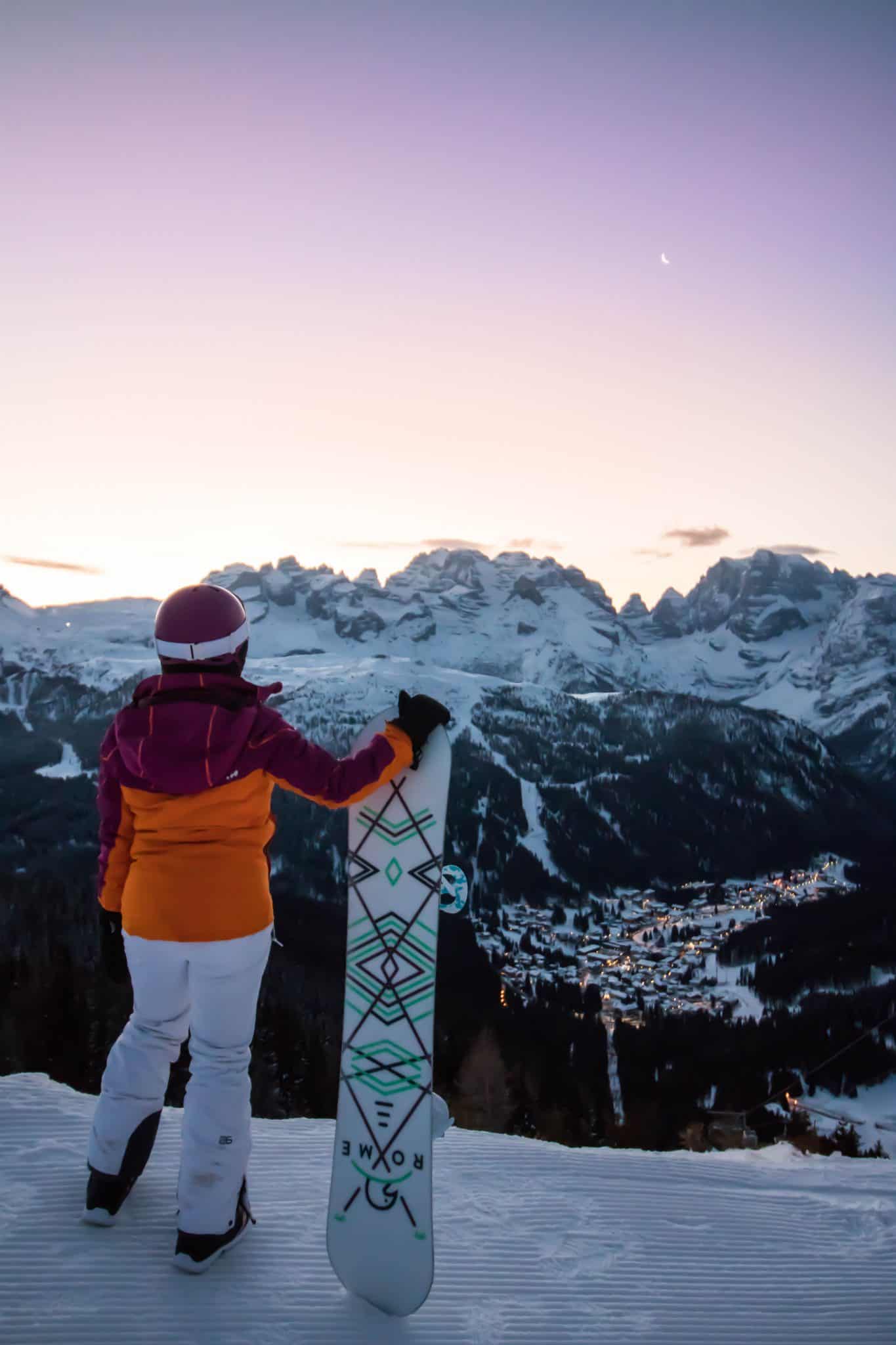
One of the best things to do in the Dolomites is skiing or snowboarding. Madonna Di Campiglio is the jewel of the ski scene in the Trentino region. It’s a well-known resort that hosts many well-heeled Italians looking for solid skiing, dining, and relaxation in a posh setting. It still holds on to its claim to fame as the summer vacation spot of Austrian Royalty and Princess Sissi.
The resort village is nearly car-free, and it’s easy to take an evening stroll after a day on the slopes. We spent our evenings window shopping while enjoying a cappuccino and admiring 19th-century architecture. Charming wooden homes line the streets, and it’s easy to see why the resort town is well cherished in Northern Italy.
Travel Details For The Dolomites
When is the Best Time to Visit the Dolomites?

If your goal is to ski in the Dolomites, the best time to visit would be between December and March. This is when areas like the Dolomiti Superski see significant snowfall and walking around towns like Cortina is like walking through a winter dream. However, if you want to hike, tackle via ferratas, or enjoy the bright blue lakes of the Dolomites, the best time to visit is between June and September. This is also the best time to visit Italy in general.
In June, hiking routes will likely still have some snow, and July and August are extremely busy and can see high temperatures. This time is also when you will likely see the highest prices on accommodation, so it’s essential to book well in advance. September and October are cooler; if you get lucky, you’ll get the most beautiful fall colors on your hikes!
How to Get Around the Dolomites?

While bus networks connect you to some sights, you’ll need a car to make the most of your time in the Dolomites. Renting a car in Italy is fairly straightforward, and rates will be more affordable if you rent in cities like Milan or Bolzano. We rented our car in Munich for an excellent rate and used that to drive all around the Alps.
Things to do in the Italian Dolomites Map

What to Pack for the Dolomites?
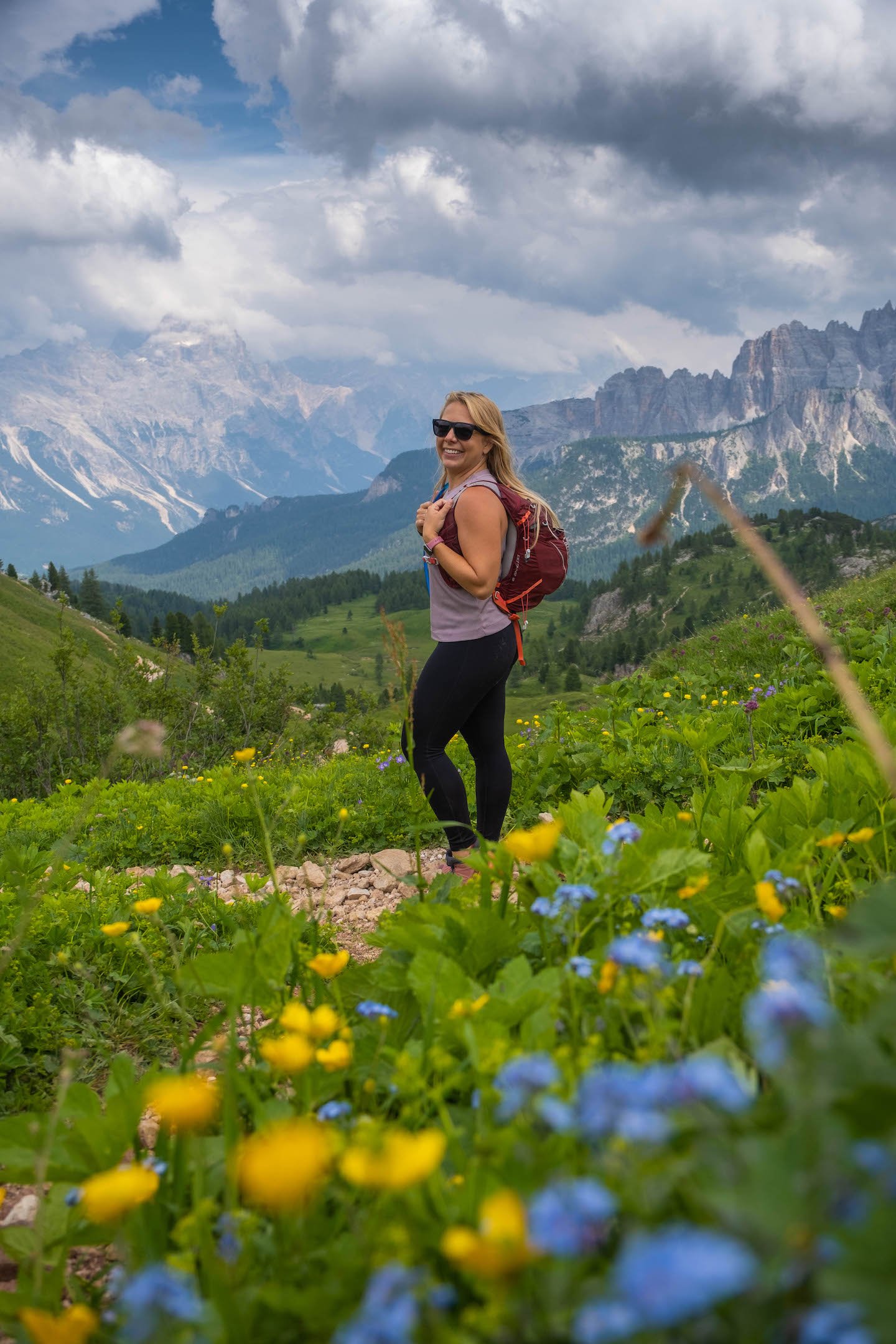
You’ll need hiking clothes for the day and trendy clothes if you plan on hanging out in the town of Cortina in the evening. At the very least, you’ll need hiking shoes, a good hiking rain jacket, a mid-layer, and hiking pants.
Oh, and when I say rain jacket, I mean a good rain jacket and even possibly rain pants. We visited the Dolomites in August, and it rained almost every afternoon. If you want to enjoy the via ferratas, it may be worth buying your equipment, depending on how many you want to do. We bought our harness and via ferrata clips at an outdoor store in Germany, which saved us from having to rent equipment for each one we wanted to tackle.
How Long Should You Spend in the Italian Dolomites?

We stayed for one week in Cortina in the summer and three nights in the winter in Madonna Di Campiglio. I barely feel like we have scratched the surface of what the Dolomites offer. After our week, we tried desperately to extend our trip, but the peak summer in the Dolomites made it tough to find anything last minute. Book your accommodation in advance here – trust me!
One week will give you a taste of the Dolomites, but if you can extend it to two weeks, I don’t think you will regret it! It’s impossible to see everything unless you plan on moving to the area, so no matter how much time you have, determine what sights are most interesting and focus on those.
Italian Dolomites Weather

The weather in this region can vary drastically depending on the time of year and altitude. In general, summers in the Dolomites are mild, with average temperatures ranging from 15-25°C (59-77°F) in the valleys and cooler temperatures at higher elevations. The weather is generally sunny and dry, although thunderstorms often occur in the afternoons. We were in the Dolomites for 8 days, and it rained 7 of those days in the middle of the afternoon – like clockwork!
Winters in the Dolomites are cold and snowy, with average temperatures ranging from -6 to 4°C (21-39°F) in the valleys and much colder temperatures at higher elevations. Snowfall is common and heavy, especially in the higher elevations, making the Dolomites a popular destination for winter sports such as skiing and snowboarding.
Overall, the Dolomites can be a pleasant destination year-round, but visitors should be prepared for weather changes and pack accordingly, especially if planning to hike or engage in outdoor activities. As with any mountain destination, layers are key.
The Best Places to Eat in the Italian Dolomites

The Dolomites region has a rich culinary tradition, and there are many excellent restaurants to choose from. A few of the best are:
- St. Hubertus, San Cassiano: A Michelin-starred restaurant that offers an innovative take on traditional South Tyrolean cuisine, located inside the Rosa Alpina Hotel & Spa it is known for its impeccable service and beautiful mountain views.
- Alpenroyal Grand Hotel Restaurant, Selva di Val Gardena: This restaurant is known for its exceptional service and elegant atmosphere, with a menu that features a mix of traditional and contemporary Italian dishes, and the wine list is extensive.
- Ristorante Ustaria Posta, San Cassiano: A family-owned restaurant that serves classic South Tyrolean dishes using locally sourced ingredients.
- Stua de Michil, Corvara: La Stüa de Michil is a cozy restaurant decorated with unique objects that adorn the wood-paneled walls, nestled between two meticulously restored 17th-century Stuben. The culinary creativity of our chef, Simone Cantafio, brings together a fusion of flavors and colors, blending East and West at the heart of the dining experience.
Plan For Your Trip
- Protect Your Trip: We don’t travel without travel insurance, nor should you. You never know what can happen while traveling, so it’s best to be prepared. HeyMondo provides excellent short-term and long-term travel insurance plans.
- Find Cheap Flights: Sign up for Going (formerly Scotts Cheap Flights) to get notified when prices get low.
- Book a Rental Car: We use Discover Car to book all our rental cars! You can also read our top tips for renting a car abroad here.
- Travel Adapter: Make sure you find a good adapter to keep your personal electronics charged. Otherwise, you may be paying for a cheap one once you land. Purchase one here.
- Travel Backpack: We like the Nomatic Travel Backpack for our travels. Check the price here.
- Our Favorite Travel Shoes: Our answer to this question is always Allbirds! Check them out on their site!
- Get a Travel Credit Card: We travel worldwide for free because we have leveraged our spending into points. See how you can do the same with our favorite travel credit cards.
READ MORE ITALY TRAVEL TIPS
I hope you enjoyed this guide on what to do in the Dolomites! Hopefully, you found it useful. Here are a few relevant articles for more travel around Italy.

